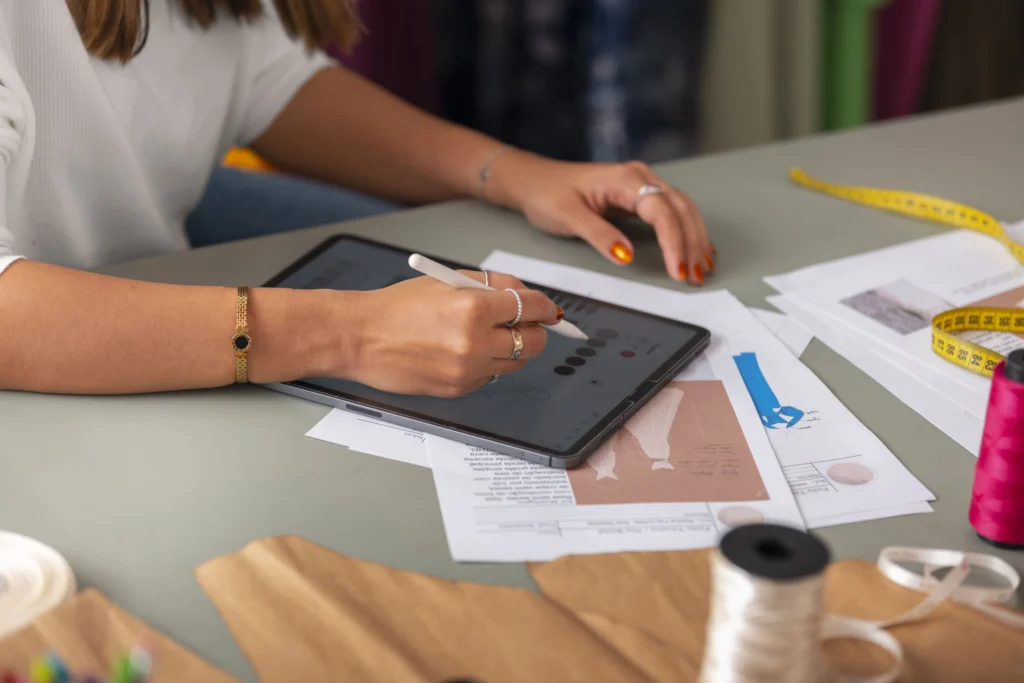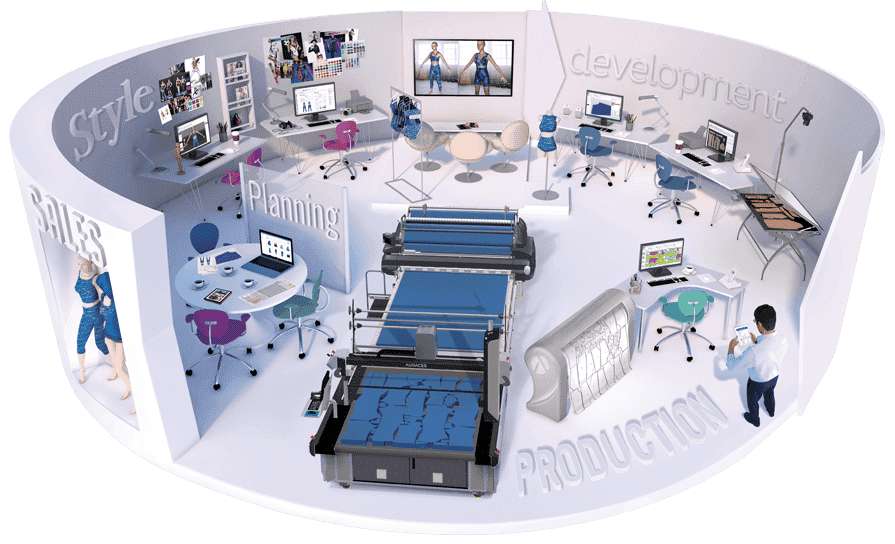Summary
- Creating your own fashion brand is a way to express your identity while filling a gap in the market.
- By following the right steps, you can make your clothing line and fulfill your entrepreneurial dream.
- Technology can be a great ally in your success. Start your Audaces360 free trial today!
Figuring out how to make a clothing line can be challenging at first. It usually starts as a side job until you can make it your main activity.
It requires an investment of time and money, and to avoid the risk of losing these important resources, following a detailed step-by-step will help you reach your goals more directly.
That’s why we have prepared a comprehensive guide to help you take each step of the way with confidence.
Enjoy your reading!
Sumário
Why start a clothing line?
If you are passionate about fashion and have an entrepreneurial spirit, starting your own clothing line is a powerful way to express your creativity.
The desire to start a business often begins from the frustration of not being able to find the desired products within the available market options.
These gaps can help you brainstorm ideas for how to make a clothing line and identify your unique selling proposition.
It could include a distinctive design style, inclusive sizing, different fits, superior quality, or more affordable pricing. Recognizing one of these unmet needs can be an opportunity to explore a new market niche.
This can take you towards the freedom of being your own boss, along with the financial rewards that a successful brand can achieve.
Also, let’s not forget the satisfaction of seeing your creations come to life and being worn by others, a great motivation to embark on this journey.
Here is a breakdown of how making a clothing line can be the next step of your career:
- Creative freedom: express your vision without limitations imposed by others.
- Filling a market need: create products that address unmet needs.
- Flexible schedule: set your own working hours.
- Financial success: building a profitable business can potentially lead to financial independence.
- Self-satisfaction: the personal fulfillment and pride of seeing your creations come to life.
- Building a team: you can expand your business and hire employees to support your growth.
Now you know the main reasons to start a clothing line, let’s discover the key steps to make it happen!
Learn more: Explore the process of crafting a successful fashion collection

How to make a clothing line in 6 steps?
There are no shortcuts to starting your own business, but there are tips and guides to make it easier and teach you about how to make a clothing line.
This step-by-step guide will help you get your plan off the ground:
1) Define your target market
Today, there are many brands producing clothing, from small ones with a well-defined value proposition for their target audience to large chains that can guarantee all trends at competitive prices.
To be successful, you need to find your unique selling proposition and it starts with defining your target market.
Identify the people for whom you want to create your collections and what their buying habits are.
To do this, you can start by answering questions like “Will my clothes be made for men or women?”, “What is the age range of the people who would be interested in my designs?” and “In what situations will the clothes be worn?”.
These answers will give you clues on how to make a clothing line.
To understand your target market better, you can conduct quantitative research, asking people to answer questions you have predefined.
To make it easier, you can create online forms with closed-ended multiple-choice answers, so the form will be easier to answer and increase the chances of people participating in your survey.
You can also conduct qualitative research, such as forming a focus group. Gather a group of people who fit the profile of the target audience you have in mind and lead conversations about their interests when buying clothes.
Learn more: Uncover the benefits of fashion trend forecasting for your clothing business
2) Choose reliable suppliers
Partnering with reliable suppliers is crucial when determining how to make a clothing line.
They must guarantee high-quality materials and services at a fair price and within the agreed delivery time.
It is also essential to verify whether they are ethical companies that operate in compliance with the law and uphold employee ethics and sustainability principles.
More than ever before, these concerns are decisive to consumers. Even if you run your business ethically, it is essential that your suppliers are aligned with these values.
To find reputable suppliers, conduct thorough online research and, if possible, arrange a personal visit to their company.
Requesting referrals from experienced fashion professionals and attending industry events are also effective ways to identify reliable professionals and businesses.
Learn more: How to perform effective supplier management in fashion
3) Create the brand name

Creating a captivating name for your brand can be a fun process, but that doesn’t minimize its importance.
It serves as the first point of contact between you and your customers, hence it should resonate with your brand’s essence and value proposition.
Prioritize a name that is easy to pronounce and recall. Otherwise, customers will struggle to remember it and recommend your brand to others.
Avoid lengthy or overly similar names to existing brands to ensure your business stands out and is not constantly compared.
Finding the perfect name may take time, so consider starting early in the project phase while still coming up with your initial ideas on how to make a clothing line.
Engage in a brainstorming session with words that evoke your product and brand aesthetic, revisiting this list periodically.
As your planning progresses, certain options will become more appealing than others. Narrow down your choices to at least your three top favorites.
Seek feedback on these names from friends, family, or even your focus group, if you have one. Gathering external perspectives is important in this decision-making process.
4) Plan your first collection
It’s time to unleash your creativity and bring your designs to life! With your target audience in mind and the initial groundwork laid, start planning your debut collection.
Today’s consumers seek clothing brands that align with their values, so keep this at the forefront of your creative process.
Developing and managing a fashion collection involves numerous elements, and you can streamline the process using digital tools like Audaces Isa, a fashion-specific PLM (Product Lifecycle Management) software that integrates all aspects of collection development.
Remember to maintain a cohesive aesthetic among the pieces, ensuring they complement each other. If your business offers both tops and bottoms, look for a balance between the two categories to achieve a well-rounded and visually appealing collection.
Learn more: 6 benefits of having an online collection management
5) Develop your designs
With your collection meticulously planned, it is time to transform your ideas into garments. Try to create innovative products that embody the essence of your brand.
Incorporating trendy items can be a good strategy to attract new customers, especially during the initial stages of your brand.
To streamline your workflow and make the best use of resources, consider investing in digital tools to assist in the development process.
They can help you save time and minimize material waste, aspects that are crucial, especially in the early stages of clothing line creation.
The Audaces suite of solutions includes Audaces Fashion Studio, a tool that allows you to design garments directly on a 3D mannequin, realistically simulating textures and draping, while effortlessly creating variations.
Additionally, Audaces Idea empowers you to design technical sketches with tech packs and pre-costs, while Audaces Pattern eases the creation of high-precision and top-quality patterns.
Learn more: Learn all about how to draw the fashion sketch for your collection
6) Sell your clothes online
Selling clothes online is the most effective way to launch your clothing line, eliminating the need for a physical store and allowing you to reach a global audience.
However, ensuring an excellent customer experience is essential. While customers cannot physically try on garments, they need to be confident in finding the correct size.
This is important for both customer satisfaction and minimizing your worries, as exchanges and returns can be costly and time-consuming.
Shape-U is a tool developed by Audaces considering all these aspects and it functions as a virtual fitting room, generating valuable customer data reports for you.
Learn more: A practical guide to sell clothes online and achieve more success
How to streamline the processes of your clothing line?

Streamlining your processes becomes an essential consideration when you are figuring out how to make a clothing line.
By optimizing your operations, you can minimize resource waste, ensure timely delivery to customers, and ultimately enhance your brand’s reputation.
Invest in technological resources
Technology plays a main role in driving precision and efficiency across your processes. Digital tools can help you maintain consistency among all produced garments, fostering a positive brand image.
In addition, technology eases seamless communication between departments, enabling you to identify bottlenecks, reduce costs, and consequently boost your profits.
Learn more: 4 key steps to streamline your fashion production process
Manage your production in real-time
Fashion PLM tools empower you to seamlessly manage your fashion collection planning process.
For example, with Audaces Isa you can leverage the mobile version to access all crucial data at your fingertips, even when you are away from the company.
Real-time control minimizes the risk of errors and rework that could potentially delay your collection launch.
Optimize marking and cutting order
Marking plays a central role in production, determining the amount of fabric utilized during the cutting stage.
Unnecessary fabric waste not only leads to financial losses but can also delay your collection. Often, inaccurate consumption calculations result in fabric shortages during production.
Tools like Audaces Marker enable you to create markings with maximum fabric utilization and precision, while Audaces Supera streamlines the management of production marking queues, enhancing the efficiency of cutting orders and saving time.
Learn more: How to obtain quality and precision in the cutting fabric process?
Continuously train your team
Ensuring that everyone involved in your creative and production processes aligns with your vision is indispensable.
To achieve this, it is your responsibility to provide ongoing training to your team, empowering them to effectively utilize your company’s software and equipment.
Continuous team training also fosters a sense of connection among employees, boosting their confidence in performing their roles.
Launch your clothing line with Audaces’ automation solutions

At Audaces, we are recognized worldwide for our innovative fashion technology solutions, meticulously developed to address the unique needs of apparel manufacturers.
Audaces360
Based on our extensive expertise, we developed Audaces360, a comprehensive suite of integrated tools that seamlessly connect every stage of your production process, from creation to production.
Audaces360 offers a wide range of functionalities, including digital technical sketches, 3D garment creation, Artificial Intelligence specially developed for fashion, pattern design and approval, fabric marking and cutting, production management, and integration with other textile machines.
The goal of these solutions is to automatize tasks to increase efficiency, reduce waste, and promote more agile and competitive production.
Find out more about how our solutions can help you. Download our interactive dashboard for free!
FAQ
If you are passionate about fashion and have an entrepreneurial spirit, starting your own clothing line is a powerful way to express your creativity.
Define your target market, choose reliable suppliers, create the brand name, plan your first collection, develop your designs, and sell your clothes online.
Invest in technological resources, manage your production in real-time, optimize marking and cutting order, and continuously train your team.










